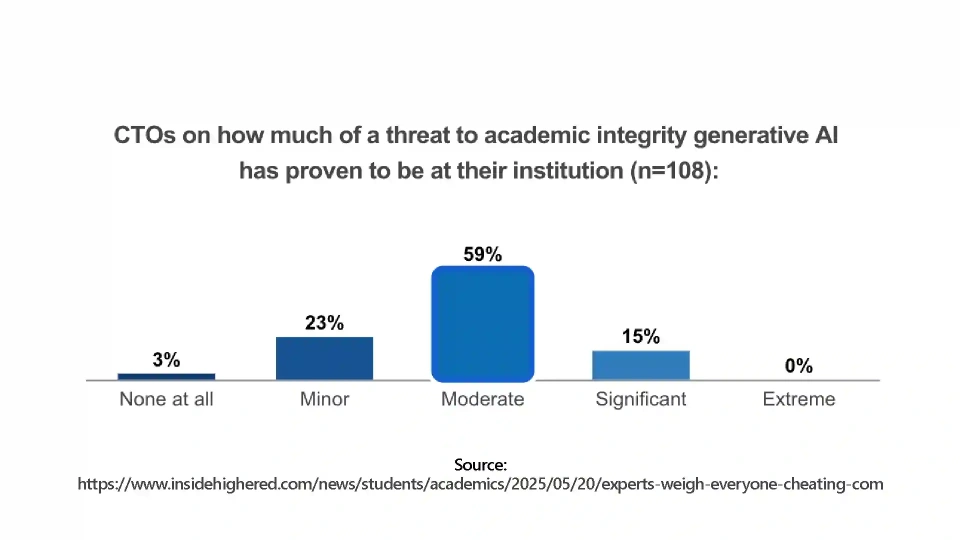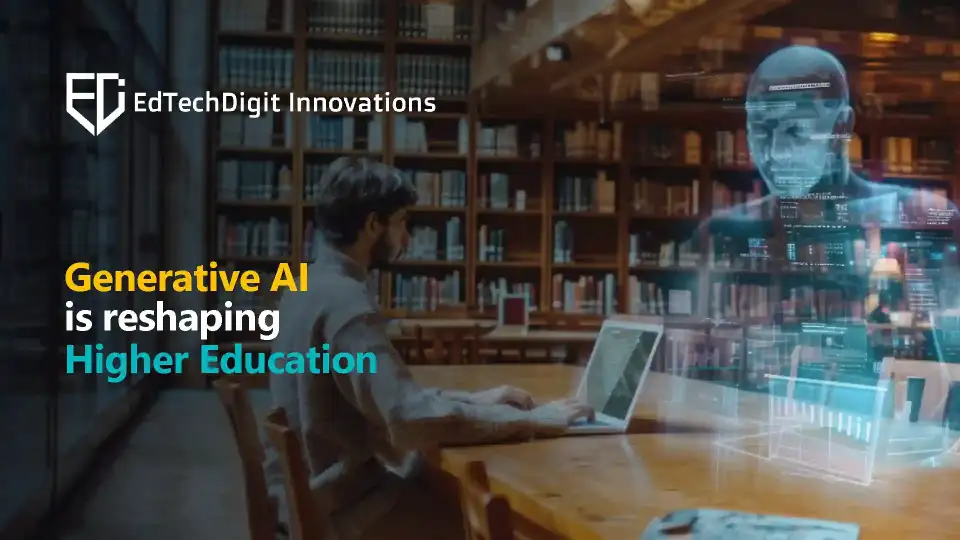Generative Artificial Intelligence (GenAI) is now seen everywhere, and its application has proliferated across all industries, work, and activities. ChatGPT, Dall-E, Gemini, DeepSeek, and the list of such small and large language models and image synthesis systems goes on. At the core of GenAI technology lies a set of machine learning techniques that help these models produce new content like texts, images, audio, or other media by learning patterns from large amounts of pre-existing data.
Contrary to other simple retrieval systems or rule-based automation, generative AI can efficiently predict next words, synthesize an image, or compose music by drawing from statistical relationships in its training corpus.
Since it can generate realistic and human-like language content, it is gaining quite popular in the education industry, and the use of generative AI in higher education has increased tremendously. Though it helps complete tasks faster and boosts creativity, it has also raised concerns regarding the overall development of students and ethical implications.
Creating New Possibilities and Opportunities for Learning
Introduction of generative AI in universities and colleges has brought numerous benefits. Now, faculty are actively using it to design better course materials, write sample problems, generate quiz questions, or create illustrative examples.
On the other hand, students are also leveraging generative AI to explore topics in depth, solving complex problems easily, using AI as a personal tutor, or to receive instant feedback. Students with any disability or those with language barriers can learn at their own pace and in the language they understand best.
This is a great tool to develop creativity among students and an effective way to explore new writing styles or simply brainstorm new ideas. If used properly, this tool can help develop metacognitive skills and help students understand how they learn. They can also understand the limitations of AI, evaluate the model’s output to determine if it is correct or not, and craft their own learning paths.
In short, generative AI is making learning more accessible, efficient, easier, and more personalized.
Risks, Challenges, and Integrity of Learning
We discussed the potential of generative AI in learning and administrative tasks in higher education. Along with great possibilities, it also comes with some real risks as well. One of the biggest concerns of using AI in higher education is academic integrity, i.e., students using AI tools to generate essays or solve assignments without putting their own effort and brain, and skipping their thinking and drafting process.
According to recent research, it is believed that the gains from AI for learning are “ephemeral”, meaning that though the performance of students may temporarily improve, in the long run, the retention and higher-order learning might suffer.
For example, writing using generative AI will definitely produce flawless content, but it shows homogeneity across all content, and students will have less recall and less mental effort.
Another risk is AI hallucination, where AI models can generate content that may look correct but is misleading or incorrect. LLMs or generative AI tools do not really understand the meaning of the content they generate; they simply replicate patterns, and therefore, they can perceive even false facts in training data as true.
Therefore, using generative AI in those areas where precise knowledge, rigor, or ethical reasoning is required can be risky. Moreover, if there is too much reliance on AI, then students will also lose their ability to think, create, reason, analyze, write, and do original work.
In a survey of Campus Chief Technology / Information Officers, about 75% said that generative AI poses a moderate or significant risk to academic integrity at their institutions. (Source: Inside Higher Ed/Hanover Research Survey 2025).

It is therefore recommended that faculty judge the contents properly, set proper standards, and enforce disciplinary heterogeneity to ensure the quality of learning.
Designing Courses and Assessments in the AI Era
Considering the risks, higher education institutions need to rethink how courses are designed and how assessments are done using AI. Instructors need to design the course and assessments that require cognitive skills of students, which AI cannot do, such as analysis, reflection, unique problem solving, etc. This will make it clear where the students can use AI-assisted tools and where they can’t.
Apart from this, it should be clearly mentioned in the syllabi if generative AI is allowed for drafts, brainstorming, or editing, and how much should be acknowledged.
Developing Generative AI Literacy Among Students and Teachers
AI literacy is another aspect that should be considered beyond just using the tools. Students and teachers should have a proper understanding of what these systems are, how they work, what their limitations are, and what their ethical and social implications could be.
This means they should know how these models are trained, how bias in training data can affect outputs, when outputs might be unreliable, and how to evaluate that reliability.
For educators, AI literacy means they should continuously update their knowledge on the latest developments and evaluate new tools for their usability. They should also adapt their teaching practices according to new technologies.
Thankfully, universities are offering support in the form of workshops, modules, consultation services, etc., to help teachers understand how to integrate AI in their classes responsibly.
What the Research So Far Suggests and What’s Next?
As of now, research shows the impact of generative AI in higher education is still evolving. Some studies reported if students are allowed to use AI in certain structured ways resulted in improved exam performance, where some reports suggest gains do not persist, especially if students continuously rely on AI for writing without internalizing learning.
Looking at the future, we can say higher education will more likely see hybrid classrooms where AI tools will have a very important role to play. It will be a great aid that will help instructors with scaffolding and students with feedback, promoting more active learning.
Moreover, we can see policies becoming more nuanced, and there will be a clear distinction between use for exploration and use for assessment.
Summing up!
Generative AI in higher education is more than just a mere technology. It is a transformative force behind how higher education now thinks about knowledge, learning, instruction, and evaluation. So, instead of focusing on whether to adopt or resist AI, universities must think about how to integrate AI into their education while preserving the integrity, depth, and human aspects of education. They must leverage the possibilities AI brings with respect to creativity, personalization, and efficiency. As we move towards the future, factors like ethical awareness, AI literacy, faculty expertise, fairness, etc., will decide how fruitful the integration of AI in higher education will be.

